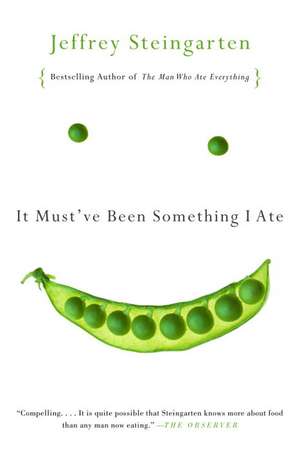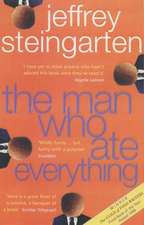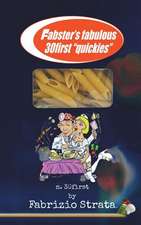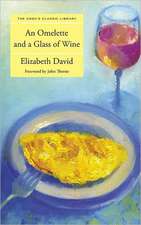It Must've Been Something I Ate: The Return of the Man Who Ate Everything
Autor Jeffrey Steingartenen Limba Engleză Paperback – 30 sep 2003
It Must’ve Been Something I Ate finds Steingarten testing the virtues of chocolate and gourmet salts; debunking the mythology of lactose intolerance and Chinese Food Syndrome; roasting marrow bones for his dog , and offering recipes for everything from lobster rolls to gratin dauphinois. The result is one of those rare books that are simultaneously mouth-watering and side-splitting.
| Toate formatele și edițiile | Preț | Express |
|---|---|---|
| Paperback (2) | 53.75 lei 3-5 săpt. | +27.48 lei 10-14 zile |
| Headline – 6 oct 2003 | 53.75 lei 3-5 săpt. | +27.48 lei 10-14 zile |
| Vintage Publishing – 30 sep 2003 | 122.93 lei 3-5 săpt. |
Preț: 122.93 lei
Nou
Puncte Express: 184
Preț estimativ în valută:
23.52€ • 24.63$ • 19.46£
23.52€ • 24.63$ • 19.46£
Carte disponibilă
Livrare economică 15-29 martie
Preluare comenzi: 021 569.72.76
Specificații
ISBN-13: 9780375727122
ISBN-10: 0375727124
Pagini: 528
Dimensiuni: 133 x 205 x 23 mm
Greutate: 0.37 kg
Editura: Vintage Publishing
ISBN-10: 0375727124
Pagini: 528
Dimensiuni: 133 x 205 x 23 mm
Greutate: 0.37 kg
Editura: Vintage Publishing
Notă biografică
Jeffrey Steingarten is Vogue's food critic and the author of The Man Who Ate Everything. He trained to be a food writer at Harvard Law School and on the Harvard Lampoon. On Bastille Day, 1994, the French Republic made Mr. Steingarten a Chevalier in the Order of Merit for his writings on French gastronomy. Chevalier Steingarten discloses that his preferred eating destinations are Memphis, Paris, Bangkok, Alba, and Chengdu--and his loft in New York City, where he has recently created well over a firkin of cultured butter.
Essays in this collection have won a National Magazine Award and several prizes from the James Beard Foundation and the International Association of Culinary Professionals. The Man Who Ate Everything was a New York Times best-seller and the winner of the Julia Child Cookbook Award and the Guild of British Food Writers Prize for the year's best book about food.
Essays in this collection have won a National Magazine Award and several prizes from the James Beard Foundation and the International Association of Culinary Professionals. The Man Who Ate Everything was a New York Times best-seller and the winner of the Julia Child Cookbook Award and the Guild of British Food Writers Prize for the year's best book about food.
Extras
TORO, TORO, TORO Aft here, drive 'em aft," I shouted. "Call all hands! Man the capstan! Blood and thunder! Lower away . . . and after him!"
I stood before the mirror in my bedroom, admiring my new outfit and rehearsing the handful of nautical phrases I had collected from my dog-eared copy of Moby-Dick. Soon I would be jetting toward Ensenada on the Pacific coast of Baja California, where I would set out upon an epic hunt for . . . the giant bluefin!
Why the bluefin? Simply because the raw meat from its belly is one of the most delicious things on Earth. Isn't that enough?
Bluefin are tuna, one of about 13 species, depending on who is doing the counting. They are among nature's most perfectly designed creatures, one of the largest fish in the sea (1,800 pounds appears to be the record) and among the fastest (capable of bursts as high as 56 miles an hour). Bluefin are able to navigate from Japan to California and back, from the Caribbean to Norway-they have binocular vision, acute hearing, sensors in their skin for pressure and temperature, and magnetic particles in their body that are thought to act as compasses. They are astonishingly streamlined, with hollows into which their fins retract and flatten at high speeds. Their bodies are 75 percent muscle. From birth until death, bluefin can never stop moving forward. If they did, they would die of suffocation. They are voracious predators, consuming up to 25 percent of their weight each day in sardines, squid, herring, and other living treats. They hunt like wolves, in deadly packs, which we call "schools," to make them seem cuter.
Bluefin are also the most valuable wild animals on Earth.
I have read that the world record for one giant bluefin is $83,500, set in 1992 at Tsukiji in Tokyo, the world's largest fish market. This comes to nearly $120 a pound. More typical auction prices these days at Tsukiji (pronounced "skee gee") range from $15 to $40 a pound, a weakness ascribed to Japan's current economic problems. The daily auctions at Tsukiji set the world prices for bluefin, because the Japanese are prepared to pay more than anybody else for their flesh. Whenever you're curious, go to fis.com, click on Market Prices, select Tokyo-Chuo under Far East Prices, and scroll down to Bluefin. I am always curious.
(Ahi tuna, a name you see printed with pride on most American menus these days, is yellowfin tuna, which the Japanese consider inferior not only to bluefin but also to southern bluefin, bigeye, and albacore, and just ahead of skipjack. "Ahi" is the Hawaiian name for yellowfin. Things Hawaiian have a special cachet in California, which they lack in the rest of the country. California is home of most American tuna canneries and restaurants there were initially fearful that customers were avoiding the dish listed as "grilled tuna." The name ahi was a godsend. On the East Coast, it sounded vaguely Japanese. Boasting of ahi on a menu is like featuring USDA Commercial grade beef at a steak house.)
The price of a bluefin depends on its size, freshness, and shape (it should be roughly football-shaped, with a swelling underside). Most important is the quality of its flesh, especially the amount and grade of toro-the pink meat from its tender, fatty belly. Bluefin experts at Tsukiji carry a sashibo, a long, thin, hollow metal rod that can be plunged under the gills and right through the fish to extract a sample of its meat, layer by layer, like a geological core.
The upper half of a bluefin's body consists of rich, shiny red meat called akami, of which the middle section, the naka, is of the highest quality. Between the upper body and the belly is a dark, bloody muscle called the chiai, which many people will not eat, though my dog, Sky King, has no compunctions. Nearly all the toro is found in the belly, which gets fattier, more delicate, and more sought after the nearer it is to the head. The middle and tail sections of the belly are medium-grade toro, chu-toro. Toward the head lies the o-toro, great toro, the most delectable and expensive fish in the world. Right behind the gills is the kama, perhaps the choicest cut on the entire bluefin, although, among some connoisseurs, just the masticatory muscle is an object of profound gastronomic worship. I had some the other day and found it a bit sinewy. Some bigeye tuna have a rare and valuable form of toro near the bones on their dorsal side, the upper body, called se-toro. I may have tasted se-toro at a little dump of a sushi place in Santa Monica, but I'm not sure.
Two thin little rectangles of o-toro (great toro) at a top sushi place in this country will cost you $20, much more in Tokyo. That is why I have never been able to eat enough toro for complete satisfaction. Well, maybe I have, just once. Sometimes, I feel like a giant bluefin, my powerful musculature propelling me about the world in search of food. Like the bluefin, if I stop, I die.
The Japanese are not alone in their love of tuna belly. I have an anatomical diagram of a bluefin published in Italy in 1919. It shows the ventresca or sorra bianca, the fatty belly, and above it, where the Japanese chu-toro lies, is the Italian tarantello. The part of the belly just behind the head-the fattiest and most valuable-appears to be called pendini or spuntatore. Things have not changed much since Pliny the Elder wrote in his Natural History, in the first century a.d.: "The choicest parts are the neck and the white flesh of the belly, and the throat, provided they are fresh. . . . The poorest parts are near the tail, because they have no fat; the parts from near the jaw are the most sought after."
Where were you when you first tasted o-toro? Me, I was in Los Angeles, ten years ago, sitting at the counter at Ginza Sushiko, a very fine sushi restaurant then in a little strip mall on Wilshire. The chef, Masa Takayama, placed two smooth pink rectangles of fish on my plate, and I took one into my mouth, unaware that this, at last, was toro. At first it was like having a second tongue in my mouth, a cooler one, and then the taste asserted itself, rich and delicately meaty, not fishy at all. The texture is easier to describe-so meltingly tender as to be nearly insubstantial, moist and cool, not buttery or velvety as people sometimes say. Have you ever tasted a piece of velvet?
I knew this was one of those peak gastronomic moments you never forget, like the last time you ate a perfect peach, or the first time you tasted a ripe, raw-milk Camembert or sautéed foie gras, or every time you have white truffles or pizza bianca. I immediately formulated a theory that moments like these draw on the collective genetic memory of the human race, reaching across national and racial lines, superseding all questions of taste, culture, habit, or custom.
Preparations for my trip to Ensenada had gone smoothly.
I can vaguely appreciate the romance of fishing. As a boy, I was able to read the first half of Ernest Hemingway's The Old Man and the Sea before losing interest. I have shared a charter or two out of Montauk, at the far tip of Long Island, to catch striped bass and bluefish (no relation to bluefin). And one of my oldest friends, usually well balanced, has become a fanatical fly fisherman. He flies to Tierra del Fuego (no joke) to catch river trout. Then, he throws them back. He does not like the taste of trout or any other fish, for that matter. His aim is to outwit these fantastically clever creatures-and, more profoundly, to subdue the primordial forces of Nature itself.
But that is not my goal. My goal is not to subdue Nature. My goal is to eat Nature.
And, let's face it. The bluefin tuna may be the most perfect creature in all the seven seas, but it is a fish nonetheless. For a human to trick a bluefin or a trout is really no contest. Sure, I enjoy vanquishing the primordial, elemental forces of the universe as much as the next guy. But for me, and for humankind since time beyond memory, the purpose of fishing is dinner.
The only snag in my plans was finding the right outfit. It was December. The weather could be balmy and dry, balmy and wet, cold yet dry, or cold and wet. I knew what I needed: a light but not flimsy shell crafted from a space-age fabric that is breathable yet waterproof. My closet was littered with 20 years' worth of allegedly breathable-yet-waterproof shells that in actuality either admitted water like cheesecloth, or hermetically held in one's body heat and moisture like a terrarium. At last, I found the ideal balance in a way overpriced shell from Patagonia in chic and slimming black. This is not the perfect color if you need to be rescued from an angry sea, but since when was high fashion meant to be practical? My friend Gloria Steinem, paraphrasing Thoreau, once told me that she avoids any occasion for which you have to buy new clothes. That's where we part ways. I feel that her view is at sharp variance with the ethos and mission of my principal employer. For the right to pursue and eat the giant bluefin, I would gladly buy any number of superfluous new outfits, while Ms. Steinem's scruples will leave her languishing on the dock.
My plan was to drive down to Ensenada and visit one of a handful of bluefin farms in the world, and probably the only one on the North American coast. Afterward, I would go in search of a tuna boat-a commercial or sports vessel-that would take me out in search of the wild giant bluefin. Ensenada is an hour and a half down the coast of Baja California from the U.S.-Mexico border crossing. The last half hour of coastline is spectacularly beautiful in any weather, and that day the air and ocean were crystalline and pure. I was driven down by Philippe Charat, a principal owner of Maricultura del Norte and its bluefin farm off the coast. (Philippe was born 60 years ago, in Paris, to a Russian father and a French mother, who took refuge in Mexico before World War II. Later, he studied at Harvard and now lives in Rancho Santa Fe, north of San Diego, as a Mexican citizen with permanent U.S. residency.) Philippe had offered to show me his operation and then help me find a tuna fishing boat. Somewhere in between, we would have a lunch of abalone and perhaps a little raw bluefin. Only the thought of lunch could alleviate my mild depression, brought on by the perfect weather, which was too warm and clear for my brand-new outfit.
We reached a rocky beach conveniently opposite Philippe's floating bluefin farm, but the water was too choppy for us to use the small company boat. And so we traveled farther down the coast, clambered into a company truck, and drove for a nauseating eternity on one of the most perilous dirt-and-rock roads I have ever known. High above the ocean, we occasionally glimpsed a magical sight-eight delicate, perfect circles on the glittering sea. These were the bluefin holding pens, in fact, not small at all, at 130 feet in diameter. At long last, we reached another beach. Disoriented and, I feared, permanently damaged, I clumsily boarded a small motorboat, and we threaded our way among the tiny pastel boats of Mexican sea-urchin divers and out onto the open water. Although these divers collect an exceptionally fine harvest, the Japanese auctioneers at Tsukiji refuse to take them; 20 minutes on this hellish road destroys their value.
The international trade in fresh bluefin developed in the 1970s, when methods of refrigeration and air-cargo handling became sophisticated enough that a giant bluefin could be caught or harpooned off the coast of New England on a Monday, and be auctioned fresh in Tokyo on Wednesday. Until then, bluefin were primarily a popular game fish, attracting celebrity sportsmen such as Hemingway, Franklin Roosevelt, Amelia Earhart, and a competitive team from Harvard to the coasts of Maine and Nova Scotia. Bluefin were a complete nuisance to commercial fishermen in the Northeast, getting tangled in their nets and yielding pennies a pound-and then only when the cat-food business was brisk. Americans did not enjoy eating oily, dark bluefin. Tuna here was a light sandwich spread canned on the Pacific coast. James Beard once wrote that tuna is the only food better canned than fresh.
Once the heady prices at Tsukiji became available to nearly every bluefin boat in the world, a fishing frenzy followed. Purse-seine technology, involving vast nets that can be drawn closed around entire schools of giant bluefin, meant that more fish could be caught by one boat in one year than by all the traditional fishermen in the world combined! By the 1990s, the world bluefin population had been reduced by 80 to 90 percent. Quotas have been enacted and poorly enforced.
These issues are the subject of bloody battles among conservationists, commercial fishermen, and sport fishermen. Satellite-tagging studies may help us to understand the life cycle and migration patterns of the bluefin, about which we know next to nothing. Bluefin farms-established years ago in Japan and later developed with Japanese help in Port Lincoln, Australia; Spain; Ensenada; and elsewhere-may someday help alleviate this potential disaster.
From the Hardcover edition.
I stood before the mirror in my bedroom, admiring my new outfit and rehearsing the handful of nautical phrases I had collected from my dog-eared copy of Moby-Dick. Soon I would be jetting toward Ensenada on the Pacific coast of Baja California, where I would set out upon an epic hunt for . . . the giant bluefin!
Why the bluefin? Simply because the raw meat from its belly is one of the most delicious things on Earth. Isn't that enough?
Bluefin are tuna, one of about 13 species, depending on who is doing the counting. They are among nature's most perfectly designed creatures, one of the largest fish in the sea (1,800 pounds appears to be the record) and among the fastest (capable of bursts as high as 56 miles an hour). Bluefin are able to navigate from Japan to California and back, from the Caribbean to Norway-they have binocular vision, acute hearing, sensors in their skin for pressure and temperature, and magnetic particles in their body that are thought to act as compasses. They are astonishingly streamlined, with hollows into which their fins retract and flatten at high speeds. Their bodies are 75 percent muscle. From birth until death, bluefin can never stop moving forward. If they did, they would die of suffocation. They are voracious predators, consuming up to 25 percent of their weight each day in sardines, squid, herring, and other living treats. They hunt like wolves, in deadly packs, which we call "schools," to make them seem cuter.
Bluefin are also the most valuable wild animals on Earth.
I have read that the world record for one giant bluefin is $83,500, set in 1992 at Tsukiji in Tokyo, the world's largest fish market. This comes to nearly $120 a pound. More typical auction prices these days at Tsukiji (pronounced "skee gee") range from $15 to $40 a pound, a weakness ascribed to Japan's current economic problems. The daily auctions at Tsukiji set the world prices for bluefin, because the Japanese are prepared to pay more than anybody else for their flesh. Whenever you're curious, go to fis.com, click on Market Prices, select Tokyo-Chuo under Far East Prices, and scroll down to Bluefin. I am always curious.
(Ahi tuna, a name you see printed with pride on most American menus these days, is yellowfin tuna, which the Japanese consider inferior not only to bluefin but also to southern bluefin, bigeye, and albacore, and just ahead of skipjack. "Ahi" is the Hawaiian name for yellowfin. Things Hawaiian have a special cachet in California, which they lack in the rest of the country. California is home of most American tuna canneries and restaurants there were initially fearful that customers were avoiding the dish listed as "grilled tuna." The name ahi was a godsend. On the East Coast, it sounded vaguely Japanese. Boasting of ahi on a menu is like featuring USDA Commercial grade beef at a steak house.)
The price of a bluefin depends on its size, freshness, and shape (it should be roughly football-shaped, with a swelling underside). Most important is the quality of its flesh, especially the amount and grade of toro-the pink meat from its tender, fatty belly. Bluefin experts at Tsukiji carry a sashibo, a long, thin, hollow metal rod that can be plunged under the gills and right through the fish to extract a sample of its meat, layer by layer, like a geological core.
The upper half of a bluefin's body consists of rich, shiny red meat called akami, of which the middle section, the naka, is of the highest quality. Between the upper body and the belly is a dark, bloody muscle called the chiai, which many people will not eat, though my dog, Sky King, has no compunctions. Nearly all the toro is found in the belly, which gets fattier, more delicate, and more sought after the nearer it is to the head. The middle and tail sections of the belly are medium-grade toro, chu-toro. Toward the head lies the o-toro, great toro, the most delectable and expensive fish in the world. Right behind the gills is the kama, perhaps the choicest cut on the entire bluefin, although, among some connoisseurs, just the masticatory muscle is an object of profound gastronomic worship. I had some the other day and found it a bit sinewy. Some bigeye tuna have a rare and valuable form of toro near the bones on their dorsal side, the upper body, called se-toro. I may have tasted se-toro at a little dump of a sushi place in Santa Monica, but I'm not sure.
Two thin little rectangles of o-toro (great toro) at a top sushi place in this country will cost you $20, much more in Tokyo. That is why I have never been able to eat enough toro for complete satisfaction. Well, maybe I have, just once. Sometimes, I feel like a giant bluefin, my powerful musculature propelling me about the world in search of food. Like the bluefin, if I stop, I die.
The Japanese are not alone in their love of tuna belly. I have an anatomical diagram of a bluefin published in Italy in 1919. It shows the ventresca or sorra bianca, the fatty belly, and above it, where the Japanese chu-toro lies, is the Italian tarantello. The part of the belly just behind the head-the fattiest and most valuable-appears to be called pendini or spuntatore. Things have not changed much since Pliny the Elder wrote in his Natural History, in the first century a.d.: "The choicest parts are the neck and the white flesh of the belly, and the throat, provided they are fresh. . . . The poorest parts are near the tail, because they have no fat; the parts from near the jaw are the most sought after."
Where were you when you first tasted o-toro? Me, I was in Los Angeles, ten years ago, sitting at the counter at Ginza Sushiko, a very fine sushi restaurant then in a little strip mall on Wilshire. The chef, Masa Takayama, placed two smooth pink rectangles of fish on my plate, and I took one into my mouth, unaware that this, at last, was toro. At first it was like having a second tongue in my mouth, a cooler one, and then the taste asserted itself, rich and delicately meaty, not fishy at all. The texture is easier to describe-so meltingly tender as to be nearly insubstantial, moist and cool, not buttery or velvety as people sometimes say. Have you ever tasted a piece of velvet?
I knew this was one of those peak gastronomic moments you never forget, like the last time you ate a perfect peach, or the first time you tasted a ripe, raw-milk Camembert or sautéed foie gras, or every time you have white truffles or pizza bianca. I immediately formulated a theory that moments like these draw on the collective genetic memory of the human race, reaching across national and racial lines, superseding all questions of taste, culture, habit, or custom.
Preparations for my trip to Ensenada had gone smoothly.
I can vaguely appreciate the romance of fishing. As a boy, I was able to read the first half of Ernest Hemingway's The Old Man and the Sea before losing interest. I have shared a charter or two out of Montauk, at the far tip of Long Island, to catch striped bass and bluefish (no relation to bluefin). And one of my oldest friends, usually well balanced, has become a fanatical fly fisherman. He flies to Tierra del Fuego (no joke) to catch river trout. Then, he throws them back. He does not like the taste of trout or any other fish, for that matter. His aim is to outwit these fantastically clever creatures-and, more profoundly, to subdue the primordial forces of Nature itself.
But that is not my goal. My goal is not to subdue Nature. My goal is to eat Nature.
And, let's face it. The bluefin tuna may be the most perfect creature in all the seven seas, but it is a fish nonetheless. For a human to trick a bluefin or a trout is really no contest. Sure, I enjoy vanquishing the primordial, elemental forces of the universe as much as the next guy. But for me, and for humankind since time beyond memory, the purpose of fishing is dinner.
The only snag in my plans was finding the right outfit. It was December. The weather could be balmy and dry, balmy and wet, cold yet dry, or cold and wet. I knew what I needed: a light but not flimsy shell crafted from a space-age fabric that is breathable yet waterproof. My closet was littered with 20 years' worth of allegedly breathable-yet-waterproof shells that in actuality either admitted water like cheesecloth, or hermetically held in one's body heat and moisture like a terrarium. At last, I found the ideal balance in a way overpriced shell from Patagonia in chic and slimming black. This is not the perfect color if you need to be rescued from an angry sea, but since when was high fashion meant to be practical? My friend Gloria Steinem, paraphrasing Thoreau, once told me that she avoids any occasion for which you have to buy new clothes. That's where we part ways. I feel that her view is at sharp variance with the ethos and mission of my principal employer. For the right to pursue and eat the giant bluefin, I would gladly buy any number of superfluous new outfits, while Ms. Steinem's scruples will leave her languishing on the dock.
My plan was to drive down to Ensenada and visit one of a handful of bluefin farms in the world, and probably the only one on the North American coast. Afterward, I would go in search of a tuna boat-a commercial or sports vessel-that would take me out in search of the wild giant bluefin. Ensenada is an hour and a half down the coast of Baja California from the U.S.-Mexico border crossing. The last half hour of coastline is spectacularly beautiful in any weather, and that day the air and ocean were crystalline and pure. I was driven down by Philippe Charat, a principal owner of Maricultura del Norte and its bluefin farm off the coast. (Philippe was born 60 years ago, in Paris, to a Russian father and a French mother, who took refuge in Mexico before World War II. Later, he studied at Harvard and now lives in Rancho Santa Fe, north of San Diego, as a Mexican citizen with permanent U.S. residency.) Philippe had offered to show me his operation and then help me find a tuna fishing boat. Somewhere in between, we would have a lunch of abalone and perhaps a little raw bluefin. Only the thought of lunch could alleviate my mild depression, brought on by the perfect weather, which was too warm and clear for my brand-new outfit.
We reached a rocky beach conveniently opposite Philippe's floating bluefin farm, but the water was too choppy for us to use the small company boat. And so we traveled farther down the coast, clambered into a company truck, and drove for a nauseating eternity on one of the most perilous dirt-and-rock roads I have ever known. High above the ocean, we occasionally glimpsed a magical sight-eight delicate, perfect circles on the glittering sea. These were the bluefin holding pens, in fact, not small at all, at 130 feet in diameter. At long last, we reached another beach. Disoriented and, I feared, permanently damaged, I clumsily boarded a small motorboat, and we threaded our way among the tiny pastel boats of Mexican sea-urchin divers and out onto the open water. Although these divers collect an exceptionally fine harvest, the Japanese auctioneers at Tsukiji refuse to take them; 20 minutes on this hellish road destroys their value.
The international trade in fresh bluefin developed in the 1970s, when methods of refrigeration and air-cargo handling became sophisticated enough that a giant bluefin could be caught or harpooned off the coast of New England on a Monday, and be auctioned fresh in Tokyo on Wednesday. Until then, bluefin were primarily a popular game fish, attracting celebrity sportsmen such as Hemingway, Franklin Roosevelt, Amelia Earhart, and a competitive team from Harvard to the coasts of Maine and Nova Scotia. Bluefin were a complete nuisance to commercial fishermen in the Northeast, getting tangled in their nets and yielding pennies a pound-and then only when the cat-food business was brisk. Americans did not enjoy eating oily, dark bluefin. Tuna here was a light sandwich spread canned on the Pacific coast. James Beard once wrote that tuna is the only food better canned than fresh.
Once the heady prices at Tsukiji became available to nearly every bluefin boat in the world, a fishing frenzy followed. Purse-seine technology, involving vast nets that can be drawn closed around entire schools of giant bluefin, meant that more fish could be caught by one boat in one year than by all the traditional fishermen in the world combined! By the 1990s, the world bluefin population had been reduced by 80 to 90 percent. Quotas have been enacted and poorly enforced.
These issues are the subject of bloody battles among conservationists, commercial fishermen, and sport fishermen. Satellite-tagging studies may help us to understand the life cycle and migration patterns of the bluefin, about which we know next to nothing. Bluefin farms-established years ago in Japan and later developed with Japanese help in Port Lincoln, Australia; Spain; Ensenada; and elsewhere-may someday help alleviate this potential disaster.
From the Hardcover edition.
Recenzii
“Compelling. . . . It is quite possible that Steingarten knows more about food than any man now eating.” –The Observer
“Whets appetites . . . adventurous, provocative and often rollicking essays.”–Newsday
“Delightful. . . . Employing courageous culinary curiosity and impressive gastronomic stamina, Steingarten happily deconstructs misinformation that hinders us as we cautiously trek to the kitchen of the nearest restaurant.” –USA Today
“Steingarten’s work will stay on the bookshelf long after our passionate colleagues have stopped competing over who can find the best osetra—and not with the food books but with the humor books funny enough to last.” –The New York Times
“Armed with a sense of adventure, a spymaster’s array of fancy gadgets, and a mind that finds it natural to introduce Boccaccio into a discussion of Parmesan cheese, he turns out little thrillers on the riddles of salt and the making of perfect pizza, salutes to chocolate and goose. Steingarten asserts that eaters ask modern cooking to be ‘stunning, original, precise, provocative, and very delicious,’ and his best prose displays those very qualities.”–Entertainment Weekly
“Like the best food, nourishes and delights.”–Boston Globe
“Endlessly entertaining and thought-provoking . . . Steingarten moves with boundless authority and wit between the search for a perfect espresso and investigations into why the Chinese don’t have all have MSG-induced headaches and whether different types of salt have different flavours. This is food-writing at its succulent best.”–The Sunday Times (London)
“Erudition, sense of humour, graceful prose, fanatical gluttony– [Steingarten]’s got it all.”–The Guardian
“The tireless culinary connoisseur is back in full force. . . . And somehow, during all his pursuits, he manages to remain an entirely likeable food snob–mainly because he’s funny, even self-deprecating.”–Time Out New York
“A witty, humorous culinary road trip, even for those with a lesser interest in food. For serious gourmets and gourmands, it is a road trip not to be missed. Read it with a food you love.”–Fort Worth Star Telegram
“Steingarten may be our most original investigative food writer.”–William Rice, Chicago Tribune
“Whets appetites . . . adventurous, provocative and often rollicking essays.”–Newsday
“Delightful. . . . Employing courageous culinary curiosity and impressive gastronomic stamina, Steingarten happily deconstructs misinformation that hinders us as we cautiously trek to the kitchen of the nearest restaurant.” –USA Today
“Steingarten’s work will stay on the bookshelf long after our passionate colleagues have stopped competing over who can find the best osetra—and not with the food books but with the humor books funny enough to last.” –The New York Times
“Armed with a sense of adventure, a spymaster’s array of fancy gadgets, and a mind that finds it natural to introduce Boccaccio into a discussion of Parmesan cheese, he turns out little thrillers on the riddles of salt and the making of perfect pizza, salutes to chocolate and goose. Steingarten asserts that eaters ask modern cooking to be ‘stunning, original, precise, provocative, and very delicious,’ and his best prose displays those very qualities.”–Entertainment Weekly
“Like the best food, nourishes and delights.”–Boston Globe
“Endlessly entertaining and thought-provoking . . . Steingarten moves with boundless authority and wit between the search for a perfect espresso and investigations into why the Chinese don’t have all have MSG-induced headaches and whether different types of salt have different flavours. This is food-writing at its succulent best.”–The Sunday Times (London)
“Erudition, sense of humour, graceful prose, fanatical gluttony– [Steingarten]’s got it all.”–The Guardian
“The tireless culinary connoisseur is back in full force. . . . And somehow, during all his pursuits, he manages to remain an entirely likeable food snob–mainly because he’s funny, even self-deprecating.”–Time Out New York
“A witty, humorous culinary road trip, even for those with a lesser interest in food. For serious gourmets and gourmands, it is a road trip not to be missed. Read it with a food you love.”–Fort Worth Star Telegram
“Steingarten may be our most original investigative food writer.”–William Rice, Chicago Tribune
Descriere
Forty outrageous, deliciously provocative pieces from "Vogue"'s indomitable food critic--the man who eats everything, dreams perpetually of the ultimate food experience, and compulsively searches out the truth about how, why, and what people eat.
























